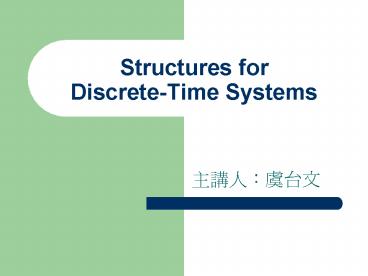Structures for Discrete-Time Systems - PowerPoint PPT Presentation
1 / 106
Title:
Structures for Discrete-Time Systems
Description:
Title: Structures for Discrete-Time Systems Author: Administrator Last modified by: Tai-Wen Yue Created Date: 12/28/2000 8:04:22 AM Document presentation format – PowerPoint PPT presentation
Number of Views:180
Avg rating:3.0/5.0
Title: Structures for Discrete-Time Systems
1
Structures forDiscrete-Time Systems
- ??????
2
Content
- Introduction
- Block Diagram Representation
- Signal Flow Graph
- Basic Structure for IIR Systems
- Transposed Forms
- Basic Structure for FIR Systems
- Lattice Structures
3
Structures forDiscrete-Time Systems
- Introduction
4
Characterize an LTI System
- Impulse Response
- z-Transform
- Difference Equation
5
Example
Noncomputable
Computable
6
Basic Operations
- Addition
- Multiplication
- Delay
In fact, there are unlimited variety of
computational structures.
Computable
7
Why Implement Using Different Structures?
- Finite-precision number representation of a
digital computer. - Truncation or rounding error.
- Modeling methods
- Block Diagram
- Signal Flow Graph
8
Block Diagram Representation
Adder
Multiplier
Unit Delay
9
Example
x(n)
y(n)
y(n?1)
y(n?2)
10
Higher-Order Difference Equations
11
Block Diagram Representation(Direct Form I)
v(n)
12
Block Diagram Representation(Direct Form I)
v(n)
13
Block Diagram Representation(Direct Form I)
v(n)
14
Block Diagram Representation(Direct Form I)
Implementing zeros
Implementing poles
v(n)
15
Block Diagram Representation(Direct Form I)
How many Adders? How many multipliers? How many
delays?
v(n)
16
Block Diagram Representation (Direct Form II)
Assume M N
17
Block Diagram Representation (Direct Form II)
Assume M N
18
Block Diagram Representation (Direct Form II)
Implementing poles
Implementing zeros
Assume M N
19
Block Diagram Representation (Direct Form II)
How many Adders? How many multipliers? How many
delays?
Assume M N
20
Block Diagram Representation (Canonic Direct Form)
21
Block Diagram Representation (Canonic Direct Form)
How many Adders? How many multipliers? How many
delays? max(M, N)
22
Structures for Discrete-Time Systems
- Signal Flow Graph
23
Nodes And Branches
Associated with each node is a variable or node
value.
wj(n)
wk(n)
24
Nodes And Branches
Input wj(n)
Output A linear transformation of input, such as
constant gain and unit delay.
Brach (j, k)
Each branch has an input signal and an output
signal.
25
More on Nodes
An internal node serves as a summer, i.e., its
value is the sum of outputs of all branches
entering the node.
26
Source Nodes
- Nodes without entering branches
27
Sink Nodes
- Nodes that have only entering branches
28
Example
Source Node
Sink Node
29
Block Diagram vs. Signal Flow Graph
w(n)
y(n)
x(n)
w1(n)
x(n)
y(n)
w2(n)
w3(n)
w4(n)
30
Block Diagram vs. Signal Flow Graph
31
Block Diagram vs. Signal Flow Graph
32
Structures for Discrete-Time Systems
- Basic Structure for IIR Systems
33
Criteria
- Reduce the number of constant multipliers
- Increase speed
- Reduce the number of delays
- Reduce the memory requirement
- Modularity VLSI design
- The effects of finite register length and
finite-precision arithmetic.
34
Basic Structures
- Direct Forms
- Cascade Form
- Parallel Form
35
Direct Forms
36
Direct Form I
37
Direct Form I
38
Direct Form II
39
Direct Form II
40
Example
0.75
2
Direct Form I
?0.125
2
0.75
Direct Form II
?0.125
41
Cascade Form
42
Cascade Form
43
Cascade Form
44
Cascade Form
x(n)
y(n)
45
Another Cascade Form
46
Parallel Form
47
Parallel Form
Group Real Poles
Complex Poles
Real Poles
Poles at zero
48
Parallel Form
49
Parallel Form
y(n)
x(n)
50
Example
51
Example
52
Structures for Discrete-Time Systems
- Transposed Forms
53
Signal Flow Graph Transformation
- To transform signal graphs into different forms
while leaving the overall system function between
input and output unchanged.
54
Transposition of Signal Flow Graph
- Reverse the directions of all arrows.
- Changes the roles of input and output.
x(n)
y(n)
x(n)
y(n)
55
Transposition of Signal Flow Graph
Are there any relations between the two systems?
56
Example
x(n)
y(n)
x(n)
y(n)
x(n)
y(n)
57
Transposition of Signal Flow Graph
- Reverse the directions of all arrows.
- Changes the roles of input and output.
Detail proof see reference
58
Structures for Discrete-Time Systems
- Basic Structure for FIR Systems
59
FIR
- For causal FIR systems, the system function has
only zeros.
60
Direct Form
61
Direct Form
62
Direct Form
63
Cascade Form
64
Cascade Form
65
Structures for Linear Phase Systems
- A generalized linear phase system satisfies
h(M?n) h(n) for n 0,1,,M
h(M?n) ?h(n) for n 0,1,,M
or
Type I
Type II
Type VI
Type III
66
Type I
67
Type I
68
Type II, III and VI
Construct them in a similar manner by yourselves.
69
Structures for Discrete-Time Systems
- Lattice Structures
70
FIR Lattice
Consider x(n)?(n), one will see
71
FIR Lattice
72
FIR Lattice
73
FIR Lattice
Define
74
FIR Lattice
Show that
75
FIR Lattice
FIR Lattice
i1
76
FIR Lattice
FIR Lattice
i n Assumed true
Prove
i n1 also true.
77
FIR Lattice
FIR Lattice
78
FIR Lattice
FIR Lattice
79
FIR Lattice
FIR Lattice
Given the lattice, to find A(z).
80
FIR Lattice
FIR Lattice
Given A(z), to find the lattice.
81
FIR Lattice
FIR Lattice
Given A(z), to find the lattice.
82
Example
0.6728
0.7952
0.9
?0.1820
?0.64
0.576
83
Example
84
Inverse Filter
85
All-Pole Filter
86
All-Pole Filter
87
All-Pole Filter
88
All-Pole Filter
89
Example
90
Example
91
Stability of All-Pole Filter
All zeros of A(z) have to lie within the unit
circle.
Necessary and sufficient conditions
All of k-parameters kis satisfy ki lt 1.
92
Normalized Lattice
93
Normalized Lattice
94
Normalized Lattice
95
Normalized Lattice
96
Normalized Lattice
Three-Multiplier Form
97
Normalized Lattice
Four-Multiplier, Kelly-Lochbaum Form
Four-Multiplier, Normalized Form
98
Normalized Lattice
99
Normalized Lattice
100
Normalized Lattice
101
Lattice Systems with Poles and Zeros
102
Lattice Systems with Poles and Zeros
103
Lattice Systems with Poles and Zeros
104
Example
105
Example
106
Example































